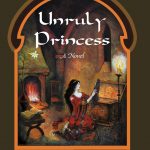
Unruly Princess.
It’s the year 1260 in the city of Buda, Hungary.
The rebellious, high-spirited Princess Margit is soon to be handed over by her father the king to the conqueror Ottakar of Bohemia. At 27, the eligible Prince is the richest and most powerful ruler in Europe. Crusader, champion and vanquisher, he’s advancing on horseback with armed escort to take over the country. He adores Margit for her beauty and heroic sanctity, and demands the willful girl as his queen.
Margit yearns only for God. Virginal and stubborn, she devotes herself to the poor and to the defense of her country. The only wedding she dreams of is a mystical union with her celestial Bridegroom. Her chosen palace is a cell, her robes are rags, her nuptial couch pillowed with straw. Margit shuns the handsome, charismatic Bohemian warrior, while Princess Cunegonda, an enchanting widow of 15, is smitten with him. Both girls, Margit and Cunegonda, will scheme to control their unique destinies.
In this tale of fighting and feasting, of royal treachery and bloodshed, feminine desire may often hold sway, both through sublime spirituality and the sensual dalliances of courtly love.
Unruly Princess differs from other narratives of Saint Margit of Hungary and her royal family, for the novel imaginatively recreates their lives from their own viewpoints. Arising from history, legend and miracle, Unruly Princess illuminates with vivacity the personalities notably of the two medieval girls, Margit and Cunegonda, as each confronts the undaunted Prince of Bohemia. Here is a romance of the court and the convent, lavish with inspiration and entertainment, inviting the reader pleasurably to step into the medieval past.
This year, 2012, marks the 770th anniversary of Saint Margit’s birth.

The Writings of Medieval Women.
An Anthology of women writers from the 3rd to the 15th centuries. 2nd edition revised and enlarged with new texts, updated notes and commentaries. Garland Publishing, New York. 1994. Routledge, New York. 536 pp.
A stunning array of the literary works of 36 women whose lives were serene, adventurous, harried, or dangerous. The chapters begin with Perpetua, 22, a nursing mother who dictated her strange dreams before being thrown to the lions in Carthage in the year 203. The final chapter presents four 15th century English women, among them Margery Kempe, who in the midst of her busy chores brewing and tending the horses in her corn-grinding mill, recorded visions of the love she experienced in the Lord’s celestial marriage bed.

Dhuoda, Handbook for her Warrior Son. Liber Manualis.
Edited and translated by Marcelle Thiébaux. Cambridge Medieval Classics 8. Cambridge University Press. 1998. Paperback, 2007. Notes and bibliography. 249pp.
This conduct-of-life guide for a teenage boy ranks as the earliest Western treatise on childhood education. The 9th century mother Dhuoda counsels William, 15, on how to survive in turbulent times and how prudently to stay on the good sides of the Church, the Emperor and his own unpredictable father, Count Bernard. The author’s introduction offers fresh views of Dhuoda’s individuality as a woman and her relationship to her husband, Bernard, a reckless, luckless brawler willing to hand over his son William as a hostage while he, Bernard, conducted an affair with the Emperor’s ravishing wife. The Introduction also discloses how William took his mother’s advice. The story of this calamity-ridden family became sensational enough to make its way into French, German and English romances of the later Middle Ages.
As an annotated scholarly edition of Dhuoda’s handbook of warnings to William, this volume provides the only complete translation in English accompanied by the Latin original.

The Passion of Saint Ursula.
(co-authored) This brief saints life, translated here for the first time into English from Passio II (Regnante Domino, 1100) hovers between history and fairy tale. A band of women presumably sailed from Britain on a pilgrimage to Rome before the 4th century. They never made it back. Legend eventually put their number at 11,000, all highborn virgins massacred by Huns in Cologne where their bones remain in St Ursula’s Church to this day. Peregrina Publishing Co., Toronto, Ontario, 1991. Introduction, text, notes, 40pp.

Ellen Glasgow
A literary biography of Pulitzer Prize winning Virginia novelist of the new industrial South, this study provides new critical reassessments of each of Glasgow’s fictional works. It demonstrates their strengths in a scheme that includes the radically changing role of women. Glasgow’s novels offer caustic views of the conditions, choices and neuroses of women as she saw them, and indicts the patriarchal social controls they endured. In her unforgettable women characters, Ellen Glasgow anticipates the writings of Faulkner and Tennesee Williams. Throughout the novels runs a feminist discourse like a dark current of ambivalence. Notes, bibliography. Frederick Ungar, 1982. 222pp.

The Stag of Love: The Chase in Medieval Literature
An eagerly practiced sport and military exercise, the chase became a metaphor in hundreds of literary texts, from antiquity to the medieval romances of French, German and English writers including Shakespeare. Hunting could represent any avid pursuit, or disaster, but none so popular as the art and mystique of love. Cupid stalked men and women, who ran after each other with yearnings like deadly weapons. Girls became quarry, men suffered torment from their own dog-like passions. After a detailed chapter on how people hunted, the book considers literature from Beowulf to Sir Gawain and the Green Knight, with acclaimed and little-known examples from the continent between the 13th and 15th centuries.
Cornell University Press. Paperback rpt., 2014. 249pp. 19 illustrations.

